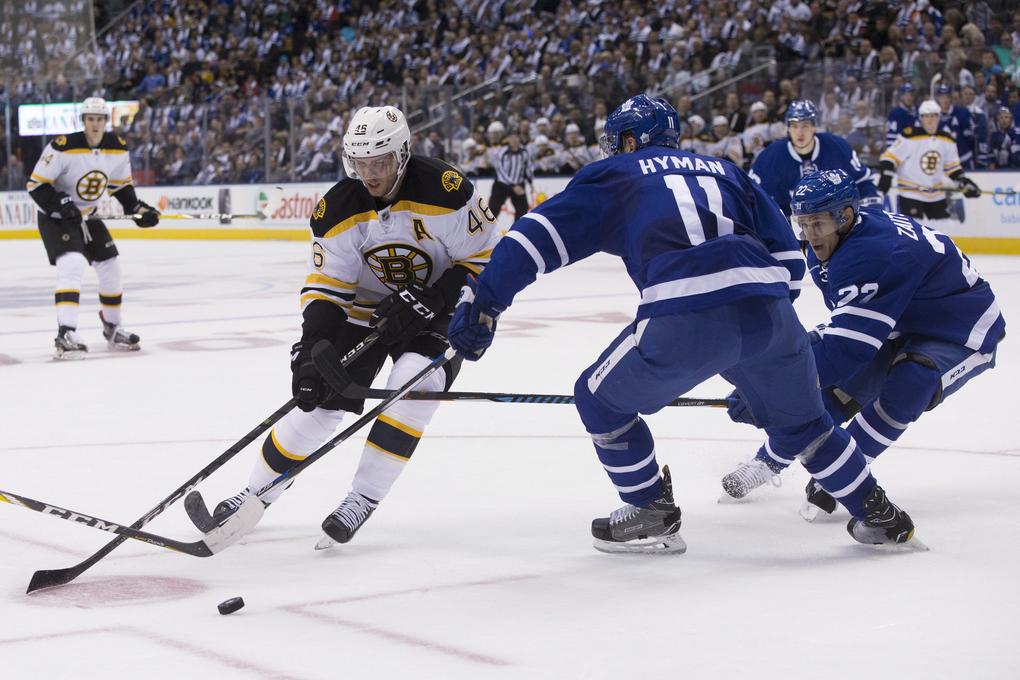
He has a new left winger, a new right winger, and a surgically repaired hip that will need at least a couple of more weeks to be back in full NHL working order.
But the best of David Krejci remains tuned and intact.
“That’s my strength — my brain, my head,’’ said the Bruins veteran center, reflecting on how the game has grown faster in his nine-plus seasons in the NHL. “I always think one or two plays ahead, and always have to remind myself, ‘Keep your feet moving, and you’re going to be OK.’ ’’
Only four games into the new season, it’s the rest of Krejci’s game that now needs to catch up with his robust cerebral skills. The Canadiens are in town Saturday night and Krejci, perennially one of the club’s most dependable offensive performers, has but a lone assist in 2016-17.
He is waiting, he said, to feel “smooth’’ on the ice, his skating stride yet to be fully restored after his offseason hip surgery. A strong and fluid skater when at full health, he has the skilled hands to deliver pucks into tight areas and the smart speed necessary to dart in and out of prime scoring areas, essential assets on the power play, whether he is working at pivot or parked at the point. Like Patrice Bergeron, the club’s other top center, he also is vital to the penalty-killing unit.
“I feel better and better,’’ he said following Friday’s workout in Brighton, where he again tuned up with rookie Danton Heinen on his left side and veteran big body David Backes on his right. “You have good days and bad days, but I feel better, so that’s a good sign.’’
Thursday night, in a 2-1 win over the Devils on Causeway Street, Krejci showed flashes of his elite-level game, particularly when getting the puck to Backes (game-high six shots on net) on his right side. He only managed one shot himself, but the essence of his game is playmaking, distributing those pucks in areas where his wingers can do damage. He finished with a team-high 46 assists last season, the second time in three years he has led the club in that category.
“I thought [Thursday] was his best game so far, in the skating area,’’ said coach Claude Julien, who needs Krejci contributing points regularly in order to have a balanced offensive attack. “When you go through [surgery], you almost expect a player to take 10 games to really find his stride. It’s a pretty significant surgery that he’s had and he is trying to catch up as far as the speed of his game, the skating and everything else. It’s normal that you are going to struggle a little bit.’’
Now 30, Krejci has worked with myriad linemates in his 10 seasons in Boston. He played on the 2011 Cup winner, often with big bodies Milan Lucic and Nathan Horton riding with him.
Thursday night, with Bergeron back on the job at pivot after sitting out the first three games, Krejci inherited the beefy Backes (6 feet 3 inches, 220 pounds) to his right and Heinen, the still-wet-behind-the-ears rookie from the University of Denver, on his left. Not only is Krejci trying to whip his hip back into shape and regain his stride, but he’s going through the typical discovery process necessary for a line to determine if it has the right chemistry.
“I thought we had some good looks,’’ he said. “I thought we had some strong forechecks and a couple of good scoring chances. Hopefully we can keep it up, look even better [vs. Montreal] and finally put one puck in the net.’’
Success comes, said Krejci, when all three linemates understand their role, know what to expect from each other.
“So you don’t have three guys with the same skill on your line,’’ he said. “You have a finisher. You have a playmaker. You have a grinder. Some kind of combination, and I feel like we have that on our line now. We just have to keep the momentum going, keep creating chances . . . and just get better every game.’’
The 63rd pick in the 2004 draft, the Czech-born Krejci naturally will begin to slow down now that he has reached his 30s. Evermore a speed game, the go-kart NHL can be unkind to those who can’t keep up, be it because of injury and a trip to the operating room, or just the interference tactics that Father Time eventually uses on everyone.
When he entered the league, noted Krejci, it was already a fast game, but upon his arrival as a 20-year-old, he recalled, every team had older players who relied more on skill than speed. Though he said he hasn’t felt the game change year to year, the perspective of a decade has made it clear to him how much the speed game now dominates the league.
“From like when I started, to now, if we skipped 10 years, yeah, there is a difference,’’ he said. “So many fast, young players are in the league now. When I first got here, there were experienced, older guys — very skilled and very good — but not as speedy as those young guys.
“You’ve got to try to be faster every year. But at the same time, there are so many fast players on the ice. You’ve got to think fast. Like in the AHL, there are players there that are faster than I am, or others here, too. But it’s a mental game. You have to think the game the right way. You have to respect the system. It’s not just about flying up and down the ice with speed.’’
Kevin Paul Dupont can be reached at kevin.dupont@globe.com. Follow him on Twitter @GlobeKPD.



